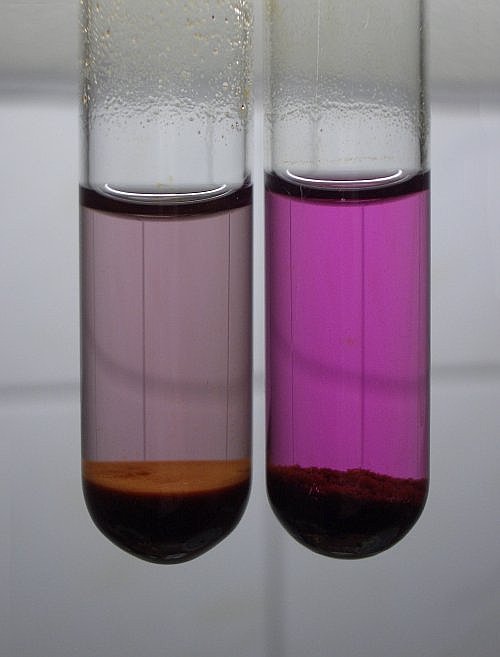


Oxidizing power of bleach
Ordinary household bleach has a remarkable oxidizing power. It is capable of oxidizing manganese to its highest oxidation state +7 and it is capable of oxidizing iron to the rare +6 oxidation state.
This experiment is appealing for people with some knowledge of chemistry, because it is one of the few examples, where manganese can be oxidized all the way up to the +7 oxidation state in aqueous environments. Normally, manganese can only be oxidized easily up to its +4 oxidation state.
Oxidation of iron, all the way up to the +6 oxidation state, even is more special.
![]()
![]() Required
chemicals:
Required
chemicals:
-
bleach, the cheapest stuff there is, without surfactants, thickeners and perfume, diluted to an active chlorine content of approximately 5%
-
any soluble iron salt (e.g. ferric chloride or Mohr's salt)
-
manganese (II) sulfate or manganese (II) chloride
![]() Required
equipment:
Required
equipment:
-
test tubes
- clamp
- heater for test tube
![]() Safety:
Safety:
- bleach is corrosive and caustic
![]() Disposal:
Disposal:
- The liquids should be flushed down the drain with lots of running water. Decant as much as possible of the liquids, without the precipitate and then rinse with a lot of water. This is important, because otherwise the bleach solution may still be present in the sink and this may cause liberation of chlorine gas later on, when an acid is flushed away.
- The remaining liquid with the precipitate can be collected in a piece of absorbing paper. The pieces of paper can be regarded as common household waste. Only a very small amount of manganese is contained in the waste, hence it is no real problem to regard it as normal waste. The test tubes themselves can be cleaned with some dilute hydrochloric acid, but this best can be done outside, due to formation of small amounts of chlorine gas from the remnants of the bleach. The acid rinse can also be flushed down the drain with a lot of water.
![]()
Procedure for performing the experiment
![]() Dissolve
a small amount (just a pinch on the tip of a spatula) of an iron salt in a small
volume of water and add some bleach to this solution. This results in formation
of a rusty brown precipitate.
Dissolve
a small amount (just a pinch on the tip of a spatula) of an iron salt in a small
volume of water and add some bleach to this solution. This results in formation
of a rusty brown precipitate.
![]() Dissolve
a small amount (just a pinch on the tip of a spatula) of manganese sulfate or
manganese chloride in a small volume of water and add some bleach to this
solution. This results in formation of a dark brown precipitate.
Dissolve
a small amount (just a pinch on the tip of a spatula) of manganese sulfate or
manganese chloride in a small volume of water and add some bleach to this
solution. This results in formation of a dark brown precipitate.
![]() Heat
both test tubes gently (without boiling) and shake gently. Do this for several
minutes for each test tube. Next set test tubes aside and let the precipitate
settle at the bottom.
Heat
both test tubes gently (without boiling) and shake gently. Do this for several
minutes for each test tube. Next set test tubes aside and let the precipitate
settle at the bottom.
The result of this experiment is shown in the picture below. At the left, one can see the rusty brown precipitate, with a dark purple/brown liquid above it. At the right, one can see the dark brown precipitate with a bright purple solution above it.

The liquid in the left test tube contains ferrate (VI) ions, FeO42-. The liquid in the right test tube contains permanganate ions, MnO4–. The latter ion is well known and the color may be familiar. The left compound, the so called ferrate, is quite rare. It only exists in strongly alkaline environments, on acidification it decomposes, forming Fe3+ and oxygen.
![]()
Discussion of results
![]() Ordinary household bleach contains hypochlorite ions, ClO–,
together with chloride, Cl–, and hydroxide, OH–. It is
produced by electrolysis and constantly mixing of brine or by passing chlorine
through a solution of sodium hydroxide.
Ordinary household bleach contains hypochlorite ions, ClO–,
together with chloride, Cl–, and hydroxide, OH–. It is
produced by electrolysis and constantly mixing of brine or by passing chlorine
through a solution of sodium hydroxide.
![]() When
this solution is added to an iron salt, then a rusty brown precipitate of iron
(III) hydroxide is formed, regardless of whether the original salt is an iron
(II) salt or an iron (III) salt:
When
this solution is added to an iron salt, then a rusty brown precipitate of iron
(III) hydroxide is formed, regardless of whether the original salt is an iron
(II) salt or an iron (III) salt:
2Fe2+ + ClO– + H2O + 4OH– → 2Fe(OH)3 + Cl–
Fe3+ + 3OH– → Fe(OH)3
![]() When
this solution is added to a manganese (II) salt, then a dark brown precipitate
of hydrous manganese (IV) oxide is formed:
When
this solution is added to a manganese (II) salt, then a dark brown precipitate
of hydrous manganese (IV) oxide is formed:
Mn2+ + ClO– + 2OH– → MnO2 + H2O + Cl–
![]() On heating, the hypochlorite is capable of oxidizing the
ferric hydroxide and hydrous manganese (IV) oxide further:
On heating, the hypochlorite is capable of oxidizing the
ferric hydroxide and hydrous manganese (IV) oxide further:
2Fe(OH)3 + 3ClO– + 4OH– → 2FeO42- + 3Cl– + 5H2O
2MnO2 + 3ClO– + 2OH– → MnO4– + 3Cl– + H2O